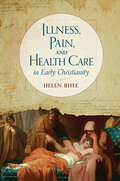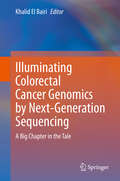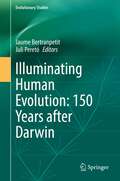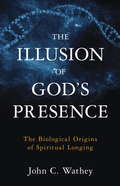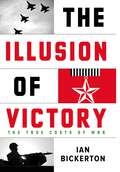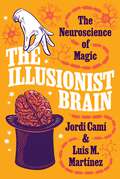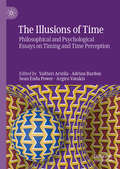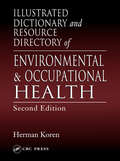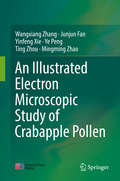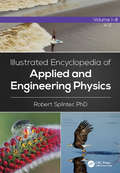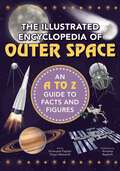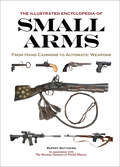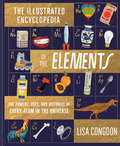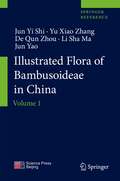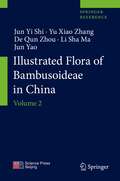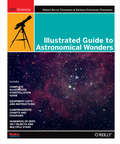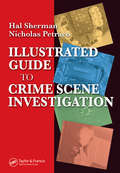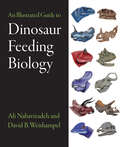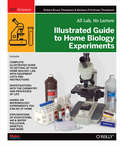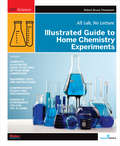- Table View
- List View
Illinois Scott Foresman Science [Grade 4]
by Timothy Cooney Jim Cummins James Flood Barbara Kay Foots M. Jenice Goldston Shirley Gholston Key Diane Lapp Sheryl A. Mercier Karen L. Ostlund Nancy Romance William Tate Kathryn C. Thornton Leon Ukens Steve WeinbergHardbound Pupil Editions for Grades 1-6 are organized into four units-Life, Physical, Earth, and Human Body sciences. An age-appropriate workbook is available for Kindergarten students.
Illness, Pain, and Health Care in Early Christianity
by Helen RheeWhat did pain and illness mean to early Christians? And how did their approaches to health care compare to those of the ancient Greco-Roman world? In this wide-ranging interdisciplinary study, Helen Rhee examines the ways early Christians viewed illness, pain, and health care—and how they were influenced both by their own tradition and by the milieu of the larger ancient world. Throughout the book, Rhee places the history of medicine, Greco-Roman literature, and ancient philosophy in fruitful dialogue with early Christian literature and theology to show the nuanced ways Christians understood, appropriated, and reformulated Roman and Byzantine conceptions of health and wholeness from the second through the sixth centuries CE. Utilizing the contemporary field of medical anthropology, Rhee engages illness, pain, and health care as sociocultural matters. Through this and other methodologies, she explores the theological meanings attributed to illness and pain; the religious status of those suffering from these and other afflictions; and the methods, systems, and rituals that Christian individuals, churches, and monasteries devised to care for those who suffered. Rhee&’s findings ultimately provide an illuminating glimpse into an instrumental way that Christians began shaping a distinct identity—both as part of and apart from their Greco-Roman world.
Illuminating Colorectal Cancer Genomics by Next-Generation Sequencing: A Big Chapter in the Tale
by Khalid El BairiThis book reviews the potential of next-generation sequencing (NGS) in research on and management of colorectal cancer (CRC), a leading cause of death worldwide and one of the most biologically and clinically heterogeneous cancers. It critically discusses findings from recent large-scale studies, clinical trials and meta-analyses and offers an introduction to the management of CRC in the era of precision medicine. In CRC, dozens of driver and passenger mutations are associated with the malignant transformation of epithelial cells. Consequently, the book discusses recent advances in our understanding of the genetics of CRC as a biomarker, the advent of NGS technologies in modern genomics, and the impact of NGS technology on the management of CRC. Furthermore, it highlights the potential of NGS in the context of liquid biopsy and single-cell sequencing in CRC, as well as its role in shedding light on the link between gut microbiota, immune-checkpoint blockade and CRC. The book concludes with a chapter on the limitations and cost-effectiveness of NGS in CRC. Given its scope, the book will appeal to all those interested in learning about the potential of NGS in advancing CRC research and patient care.
Illuminating Dark Matter: Proceedings of a Simons Symposium (Astrophysics and Space Science Proceedings #56)
by Rouven Essig Jonathan Feng Kathryn ZurekBased on a Simons Symposium held in 2018, the proceedings in this volume focus on the theoretical, numerical, and observational quest for dark matter in the universe. Present ground-based and satellite searches have so far severely constrained the long-proposed theoretical models for dark matter. Nevertheless, there is continuously growing astrophysical and cosmological evidence for its existence. To address present and future developments in the field, novel ideas, theories, and approaches are called for. The symposium gathered together a new generation of experts pursuing innovative, more complex theories of dark matter than previously considered.This is being done hand in hand with experts in numerical astrophysical simulations and observational techniques—all paramount for deciphering the nature of dark matter. The proceedings volume provides coverage of the most advanced stage of understanding dark matter in various new frameworks. The collection will be useful for graduate students, postdocs, and investigators interested in cutting-edge research on one of the biggest mysteries of our universe.
Illuminating Human Evolution: 150 Years after Darwin (Evolutionary Studies)
by Jaume Bertranpetit Juli PeretóThis book presents a series of perspectives showing the current knowledge about human evolution. On the occasion of the 150th anniversary of Darwin's book, The Descent of Man, and Selection in Relation to Sex, in which he explicitly addresses the natural origin of the human species, this collective work reviews current and diverse aspects of human evolution: from psychology, linguistics, genomics, paleontology, artistic expression or sexual selection. It also offers a historical, social and ideological context of what is often considered to be Darwin's second great work after The Origin of Species.Although current research is concentrated largely on fossils and genomes, this book also deals with the main points Darwin centered his attention on; comparative morphology and psychology, and sexual selection. It also covers other new aspects, such as the origin of art, social structure and social learning. With contributions from leading experts in their respective fields, the book guides readers to the study of the social context of Darwin and his time, and the state of the art of studies on human evolution and sexual selection, considering all aspects that Darwin examined, including those that emerged later and now are important disciplines in our understanding of our own evolution.The English translation of parts of this book from its Spanish original manuscript was done with the help of artificial intelligence (machine translation by the service DeepL.com). A subsequent human revision was done primarily in terms of content.
The Illusion of God's Presence
by John C. WatheyAn essential feature of religious experience across many cultures is the intuitive feeling of God's presence. More than any rituals or doctrines, it is this experience that anchors religious faith, yet it has been largely ignored in the scientific literature on religion.Starting with a vivid narrative account of the life-threatening hike that triggered his own mystical experience, biologist John Wathey takes the reader on a scientific journey to find the sources of religious feeling and the illusion of God's presence. His book delves into the biological origins of this compelling feeling, attributing it to innate neural circuitry that evolved to promote the mother-child bond. Dr. Wathey, a veteran neuroscientist, argues that evolution has programmed the infant brain to expect the presence of a loving being who responds to the child's needs. As the infant grows into adulthood, this innate feeling is eventually transferred to the realm of religion, where it is reactivated through the symbols, imagery, and rituals of worship. The author interprets our various conceptions of God in biological terms as illusory supernormal stimuli that fill an emotional and cognitive vacuum left over from infancy. These insights shed new light on some of the most vexing puzzles of religion, like the popular belief in a god who is judgmental and punishing, yet also unconditionally loving; the extraordinary tenacity of faith; the greater religiosity of women relative to men; religious obsessions with sex; the mysterious compulsion to pray; the seemingly irrepressible feminine attributes of God, even in traditionally patriarchal religions; and the strange allure of cults. Finally, Dr. Wathey considers the hypothesis that religion evolved to foster reproductive success, arguing that, in an age of potentially ruinous overpopulation, magical thinking has become a luxury we can no longer afford, one that distracts us from urgent threats to our planet.Deeply researched yet elegantly written in a jargon-free and accessible style, this book presents a compelling interpretation of the evolutionary origins of spirituality and religion.From the Hardcover edition.
Illusion Of Victory: The True Costs of Modern War
by Ian BickertonThe Illusion of Victory demonstrates that most of the rewards of victory in modern warfare are either exaggerated or false. When the ostensible benefits of victory are examined a generation after a war, it becomes inescapably evident that the defeated belligerent rarely conforms to the demands and expectations of the victor. Consequently, long-term political and military stability is denied to both the victorious power and to the defeated one. As a result, neither victory nor defeat deter further outbreaks of war. This sobering reality is increasingly the case in the twentieth and twenty-first centuries. Ian Bickerton persuasively argues that as the rhetoric of victory becomes more hollow all countries must adopt creative new approaches to resolving disputes.
The Illusionist Brain: The Neuroscience of Magic
by Jordi Camí Luis M. MartínezHow magicians exploit the natural functioning of our brains to astonish and amaze usHow do magicians make us see the impossible? The Illusionist Brain takes you on an unforgettable journey through the inner workings of the human mind, revealing how magicians achieve their spectacular and seemingly impossible effects by interfering with your cognitive processes. Along the way, this lively and informative book provides a guided tour of modern neuroscience, using magic as a lens for understanding the unconscious and automatic functioning of our brains.We construct reality from the information stored in our memories and received through our senses, and our brains are remarkably adept at tricking us into believing that our experience is continuous. In fact, our minds create our perception of reality by elaborating meanings and continuities from incomplete information, and while this strategy carries clear benefits for survival, it comes with blind spots that magicians know how to exploit. Jordi Camí and Luis Martínez explore the many different ways illusionists manipulate our attention—making us look but not see—and take advantage of our individual predispositions and fragile memories.The Illusionist Brain draws on the latest findings in neuroscience to explain how magic deceives us, surprises us, and amazes us, and demonstrates how illusionists skillfully “hack” our brains to alter how we perceive things and influence what we imagine.
Illusions of Seeing: Exploring the World of Visual Perception
by Thomas DitzingerWhy do we need two eyes? Why are all cats grey at night and appear to move faster the day? Why is the sky blue and the setting sun red? This book explains the multifaceted nature of perception, and discusses the mysteries of vision. It provides readers with experiments to help them discover optical illusions and the features of their own perception. Illusions of Seeing begins with a discussion on the essence of light and its perception to the human eye. It presents a comprehensive overview of the basic laws of human perception as well as the fundamentals of good gestalt. Subsequent chapters discuss geometric-optical illusions; the perception of form, brightness, and translucency and their interaction with each other; ambiguous perception, color vision, spatial vision. The book ends with a discussion of the perception of motion and its interaction with color, form, and spatial depth with a full chapter devoted to illusions in our everyday life. Consider this your travel guide in the marvelous world of sight, to experience a completely individual way to understand and improve your own perception.Illusions of Seeing will be of interest to psychologists, physicists, biologists, and undergraduate and graduate students within the field of cognitive psychology.
The Illusions of Time: Philosophical and Psychological Essays on Timing and Time Perception
by Adrian Bardon Valtteri Arstila Sean Enda Power Argiro VatakisThis edited collection presents the latest cutting-edge research in the philosophy and cognitive science of temporal illusions. Illusion and error have long been important points of entry for both philosophical and psychological approaches to understanding the mind. Temporal illusions, specifically, concern a fundamental feature of lived experience, temporality, and its relation to a fundamental feature of the world, time, thus providing invaluable insight into investigations of the mind and its relationship with the world. The existence of temporal illusions crucially challenges the naïve assumption that we can simply infer the temporal nature of the world from experience. This anthology gathers eighteen original papers from current leading researchers in this subject, covering four broad and interdisciplinary topics: illusions of temporal passage, illusions and duration, illusions of temporal order and simultaneity, and the relationship between temporal illusions and the cognitive representation of time.
Illustrated Dictionary and Resource Directory of Environmental and Occupational Health
by Herman KorenThe Illustrated Dictionary and Resource Directory of Environmental and Occupational Health, Second Edition is a one-of-a-kind, comprehensive reference source for the vast and diverse collection of interrelated terms and topics that encompass the fields of environmental science, occupational health and safety, and preventive medicine. These topics i
An Illustrated Electron Microscopic Study of Crabapple Pollen
by Wangxiang Zhang Junjun Fan Yinfeng Xie Ye Peng Ting Zhou Mingming ZhaoThis book focuses on the morphology, exine ornamentation and the associated evolutionary trends of crabapple pollen and anatomical developmental patterns. To examine the genetic evolutionary patterns of crabapple pollen traits, we constructed an interval distribution function based on characteristic pollen parameters and used a binary trivariate data matrix (Xi Yi Zi) to reflect the exine ornamentation regularity of the pollen. Our findings should inform the taxonomic status of the genus Malus.Pollen electron micrographs from a total of 26 species and 81 cultivars of Malus were recorded in this book. All 107 figures and 642 scanned pollen images constitute primary data obtained by the authors. The images in this book are clear, three-dimensional, and aesthetically pleasing. They are accompanied with text descriptions and provided a method for the indication of the different types of information that can be expected.This book can provide a reference for scientific researchers, students, and teachers in tertiary institutions that are engaged in research concerning crabapple production.
Illustrated Encyclopedia of Applied and Engineering Physics, Three-Volume Set
by Robert SplinterThis resource provides a single, concise reference containing terms and expressions used in the study, practice, and application of physical sciences. The reader will be able to identify quickly critical information about professional jargon, important people, and events. The encyclopedia gives self-contained definitions with essentials regarding the meaning of technical terms and their usage, as well as about important people within various fields of physics and engineering, with highlights of technical and practical aspects related to cross-functional integration. It will be indispensable for anyone working on applications in biomedicine, materials science, chemical engineering, electrical engineering, mechanical engineering, geology, astronomy, and energy. It also includes handy tables and chronological timelines organized by subject area and giving an overview on the historical development of ideas and discovery.
The Illustrated Encyclopedia of Outer Space: An A to Z Guide to Facts and Figures
by Diego Mattarelli Emanuela PagliariAstronauts, rockets, and stars—oh my! Learn everything about outer space from A to Z! This isn&’t your normal alphabet book. Instead of reading about apples and zebras, your child can learn planets and galaxies! Each letter in this fun alphabet book pertains to an important topic that explores space and space travel. Packed with information and curiosities, children will learn about: Black holesMeteorsSpace StationsOrbitsRocket scientistsAnd more! Kids get enough of simple words in school and not all kids are interested in the alphabet and reading. Pique their interest with this colorful, illustrated book that they will be wanting to read again and again. Encourage your kids to learn their alphabet by associating fun facts about space to each letter. After reading this picture book, young readers will be able to say with confidence that they know space from A to Z!
The Illustrated Encyclopedia of Small Arms: From Hand Cannons to Automatic Weapons
by Rupert MatthewsThis comprehensive, fully illustrated reference volume covers the evolution of small arms from primitive spears to portable rocket launchers.The Illustrated Encyclopedia of Small Arms details more than 1,000 weapons, complete with full-color photographs. Featuring arms from around the world and across history, this stunning guide highlights the intricacies that make each variety unique, tying in historical anecdotes as well as the history of certain brands. Revealing fascinating insights and historical episodes—such as the inspiration for Samuel L. Colt&’s revolvers, or the lozenge-case gun used by Italian spies during World War II—this is an ideal resource for historians as well as fire arms enthusiasts. The volume is lushly illustrated with detailed photographs, many of which are published here for the first time.
Illustrated Encyclopedia of the Elements: The Powers, Uses, And Histories Of Every Atom In The Universe
by Lisa CongdonA gorgeous nonfiction book for kids from bestselling artist and author Lisa Congdon!The Illustrated Encyclopedia of the Elements leads young readers in an exploration of all 118 known elements.From their discoveries to their uses to their special properties, this vibrant book explores all things elements.• A visually stunning tour of the periodic table• Complete with profiles of notable scientists, amazing infographics, and more• Features an illustrated history of the periodic table's originsThis artful survey of the elements combines science, history, trivia, humor, and endless fascination for science enthusiasts of every age.Middle grade readers will delight in this interesting take on the periodic table of elements. • Great for science lovers and Lisa Congdon fans alike• Resonates year-round as a go-to gift for birthdays and holidays for the science-loving kid• Perfect for children ages 10 and up• Equal parts educational and entertaining, this makes a great pick for parents and grandparents, as well as librarians, science teachers, and STEM educators.• You'll love this book if you love books like The Elements Book: A Visual Encyclopedia of the Periodic Table by DK, The Periodic Table by Sean Callery and Miranda Smith, and Elements: A Visual Exploration of Every Known Atom in the Universe by Theodore Gray.
Illustrated Flora of Bambusoideae in China: Volume 1
by Jun Yao Jun Yi Shi Yu Xiao Zhang De Qun Zhou Li Sha MaThis book was compiled by researchers of Chinese Academy of Forestry, Sichuan Agricultural University, Southwest Forestry University, Kunming University of Science and Technology, and Chinese Academy of Sciences. It has been the most comprehensive monograph about the bamboo resources in China until now."Illustrated Flora of Bambusoideae in China" is composed of two volumes. Volume 1 contains prefaces written by Shougong Zhang and Dezhu Li and the foreword by the authors, and 28 chapters, i.e., Morphology of Bamboos, Geographical Distribution of Bambusoideae, Hardiness Zones of Bambusoideae in China, 16 genera of the tribe Bambusese (Bambusa, Bonia, Cephalostachyum, Dendrocalamopsis, Dendrocalamus, Gigantochloa, Guadua, Leptocanna, Lingnania, Melocalamus, Melocanna, Neomicrocalamus, Neosinocalamus, Pseudostachyum, Schizostachyum, Thyrsostachys), and 9 genera of the tribe Arundinarieae (Brachystachyum, Chimonobambusa, Hibanobambusa, Indosasa, Phyllostachys,Qiongzhuea, Semiarundinaria, Shibataea, Sinobambusa). Totally, 512 bamboo taxa are recorded in volume 1, including 4 hybrids, 119 forms, 38 varieties, and 351 species in 25 genera.
Illustrated Flora of Bambusoideae in China: Volume 2
by Jun Yao Jun Yi Shi Yu Xiao Zhang De Qun Zhou Li Sha MaThis book was compiled by researchers of Chinese Academy of Forestry, Sichuan Agricultural University, Chinese Academy of Sciences, Southwest Forestry University, and Kunming University of Science and Technology. It has been the most comprehensive monograph about the bamboo resources in China until now. "Illustrated Flora of Bambusoideae in China" is composed of two volumes. Volume 2 consists of 18 chapters corresponding to 18 genera of the tribe Arundinarieae (i.e., Acidosasa, Ampelocalamus, Bashania, Chimonocalamus, Drepanostachyum, Fargesia, Ferrocalamus, Gaoligongshania, Gelidocalamus, Indocalamus, Menstruocalamus, Oligostachyum, Pleioblastus, Pseudosasa, Sasa, Sasaella, Thamnocalamus, Yushania). Sixteen forms, 17 varieties, and 397 species in 18 genera are included in this volume (430 taxa in total).
Illustrated Guide to Astronomical Wonders: From Novice to Master Observer
by Robert Bruce Thompson Barbara Fritchman ThompsonWith the advent of inexpensive, high-power telescopes priced at under $250, amateur astronomy is now within the reach of anyone, and this is the ideal book to get you started. The Illustrated Guide to Astronomical Wonders offers you a guide to the equipment you need, and shows you how and where to find hundreds of spectacular objects in the deep sky -- double and multiple stars as well as spectacular star clusters, nebulae, and galaxies.You get a solid grounding in the fundamental concepts and terminology of astronomy, and specific advice about choosing, buying, using, and maintaining the equipment required for observing. The Illustrated Guide to Astronomical Wonders is designed to be used in the field under the special red-colored lighting used by astronomers, and includes recommended observing targets for beginners and intermediate observers alike. You get detailed start charts and specific information about the best celestial objects.The objects in this book were chosen to help you meet the requirements for several lists of objects compiled by The Astronomical League.Binocular Messier ClubUrban Observing ClubDeep Sky Binocular ClubDouble Star ClubRASC Finest NGC ListCompleting the list for a particular observing club entitles anyone who is a member of the Astronomical League or RASC to an award, which includes a certificate and, in some cases, a lapel pin.This book is perfect for amateur astronomers, students, teachers, or anyone who is ready to dive into this rewarding hobby. Who knows? You might even find a new object, like amateur astronomer Jay McNeil. On a clear cold night in January 2004, he spotted a previously undiscovered celestial object near Orion, now called McNeil's Nebula. Discover what awaits you in the night sky with the Illustrated Guide to Astronomical Wonders.
An Illustrated Guide to Congenital Heart Disease: From Diagnosis to Treatment – From Fetus to Adult
by In Sook ParkThis book combines an exceptional wealth of precise, exquisite schematic drawings and high-quality images with clear explanatory text in order to provide readers with a crisp and clear understanding of all aspects of congenital heart disease, from diagnosis to treatment and from the fetus to the adult. In format the book appears similar to a large collection of case reports covering all types of congenital heart disease, including complex lesions such as single ventricle and atrial isomerism. For each lesion, the illustrations are placed before the text so that the reader can gain a quick and general overview before going into more detail. The contents are as practical and concise as possible. The intention is that, despite its size, the book will serve as a handy reference for cardiologists, surgeons, intensivists, obstetricians specializing in fetal sonography, nurses, trainees, students, researchers, and even patients and their families. This is a “must-have” bedside reference in the cardiac ward, the ICU, and the fetal sonography room and will even be valuable in outpatient clinics.
Illustrated Guide to Crlme Scene Investigation
by Nicholas Petraco Hal ShermanYou are the first to arrive at the scene. You secure the area, and record what the human eye can see so far. You begin your search. You come across what appears to be physical evidence, and proceed to carefully document, package, and transport it to the lab. You fill out the routine paperwork, and feel secure in the knowledge that you have done eve
An Illustrated Guide to Dinosaur Feeding Biology
by Ali Nabavizadeh David B. WeishampelThis beautifully illustrated exploration of the diversity, anatomy, and evolution of dinosaur feeding adaptations is the first and only in-depth look at this crucial aspect of paleoecology.In An Illustrated Guide to Dinosaur Feeding Biology, experts Ali Nabavizadeh and David B. Weishampel bring dinosaurs to life on the page by exploring and illustrating their feeding adaptations. Whether dinosaurs were carnivorous, herbivorous, or omnivorous, their evolution produced a multitude of specialized adaptations that helped shape their ecologies. Dinosaur skulls show a variety of bone and joint specializations ideal for withstanding stresses and strains induced by high bite forces with strong jaw musculature. The bladed, steak-knife dentition of many carnivorous dinosaurs was well-suited for slicing meat and crushing bones, while the leaf-shaped, sometimes tightly packed dentition of many herbivorous dinosaurs was ideal for grinding up a variety of plant material.The first book of its kind, An Illustrated Guide to Dinosaur Feeding Biology is a synthesis of over a century of dinosaur feeding biology research, from the earliest hypotheses in the 1800s to today's studies using advanced techniques. Intended for both researchers and dinosaur enthusiasts alike, this book discusses functional morphological studies highlighting comparative anatomy, tooth wear, muscle reconstruction, and biomechanical analysis using modeling techniques like finite element analysis and multibody dynamics analysis. In addition to the feeding apparatus, Nabavizadeh and Weishampel explore postcranial adaptations and discuss the evolution of dinosaurs and their paleoecology more broadly. Integrating these various factors improves our understanding of dinosaurs as the living beings they were in their ecosystems millions of years ago and ultimately expands our knowledge and perspective of today's ecosystems by framing them in a broader evolutionary context.
Illustrated Guide to Home Biology Experiments: All Lab, No Lecture
by Robert Bruce Thompson Barbara Fritchman ThompsonExperience the magic of biology in your own home lab. This hands-on introduction includes more than 30 educational (and fun) experiments that help you explore this fascinating field on your own. Perfect for middle- and high-school students and DIY enthusiasts, this full-color guide teaches you the basics of biology lab work and shows you how to set up a safe lab at home.The Illustrated Guide to Home Biology Experiments is also written with the needs of homeschoolers firmly in mind, as well as adults who are eager to explore the science of nature as a life-long hobby. To get the most from the experiments, we recommend using this guide in conjunction with a standard biology text, such as the freely downloadable CK-12 Biology (ck-12.org).Master the use of the microscope, including sectioning and stainingBuild and observe microcosms, soda-bottle worlds of pond lifeInvestigate the chemistry of life from simple acids, bases, and buffers to complex carbohydrates, proteins, lipids, enzymes, and DNAExtract, isolate, and observe DNAExplore photosynthesis, osmosis, nitrogen fixation, and other life processesInvestigate the cell cycle (mitosis and cytokinesis)Observe populations and ecosystems, and perform air and water pollution testsInvestigate genetics and inheritanceDo hands-on microbiology, from simple culturing to micro-evolution of bacteria by forced selectionGain hands-on lab experience to prepare for the AP Biology examThrough their company, The Home Scientist, LLC (thehomescientist.com/biology), the authors also offer inexpensive custom kits that provide specialized equipment and supplies you’ll need to complete the experiments. Add a microscope and some common household items and you’re good to go.
Illustrated Guide to Home Chemistry Experiments: All Lab, No Lecture
by Robert Bruce ThompsonFor students, DIY hobbyists, and science buffs, who can no longer get real chemistry sets, this one-of-a-kind guide explains how to set up and use a home chemistry lab, with step-by-step instructions for conducting experiments in basic chemistry -- not just to make pretty colors and stinky smells, but to learn how to do real lab work:Purify alcohol by distillationProduce hydrogen and oxygen gas by electrolysisSmelt metallic copper from copper ore you make yourselfAnalyze the makeup of seawater, bone, and other common substancesSynthesize oil of wintergreen from aspirin and rayon fiber from paperPerform forensics tests for fingerprints, blood, drugs, and poisonsand much moreFrom the 1930s through the 1970s, chemistry sets were among the most popular Christmas gifts, selling in the millions. But two decades ago, real chemistry sets began to disappear as manufacturers and retailers became concerned about liability. ,em>The Illustrated Guide to Home Chemistry Experiments steps up to the plate with lessons on how to equip your home chemistry lab, master laboratory skills, and work safely in your lab. The bulk of this book consists of 17 hands-on chapters that include multiple laboratory sessions on the following topics:Separating MixturesSolubility and SolutionsColligative Properties of SolutionsIntroduction to Chemical Reactions & StoichiometryReduction-Oxidation (Redox) ReactionsAcid-Base ChemistryChemical KineticsChemical Equilibrium and Le Chatelier's PrincipleGas ChemistryThermochemistry and CalorimetryElectrochemistryPhotochemistryColloids and SuspensionsQualitative AnalysisQuantitative AnalysisSynthesis of Useful CompoundsForensic ChemistryWith plenty of full-color illustrations and photos, Illustrated Guide to Home Chemistry Experiments offers introductory level sessions suitable for a middle school or first-year high school chemistry laboratory course, and more advanced sessions suitable for students who intend to take the College Board Advanced Placement (AP) Chemistry exam. A student who completes all of the laboratories in this book will have done the equivalent of two full years of high school chemistry lab work or a first-year college general chemistry laboratory course.This hands-on introduction to real chemistry -- using real equipment, real chemicals, and real quantitative experiments -- is ideal for the many thousands of young people and adults who want to experience the magic of chemistry.
Illustrated Guide to Home Forensic Science Experiments: All Lab, No Lecture
by Robert Bruce Thompson Barbara Fritchman ThompsonHave you ever wondered whether the forensic science you’ve seen on TV is anything like the real thing? There’s no better way to find out than to roll up your sleeves and do it yourself. This full-color book offers advice for setting up an inexpensive home lab, and includes more than 50 hands-on lab sessions that deal with forensic science experiments in biology, chemistry, and physics. You’ll learn the practical skills and fundamental knowledge needed to pursue forensics as a lifelong hobby—or even a career.The forensic science procedures in this book are not merely educational, they’re the real deal. Each chapter includes one or more lab sessions devoted to a particular topic. You’ll find a complete list of equipment and chemicals you need for each session.Analyze soil, hair, and fibersMatch glass and plastic specimensDevelop latent fingerprints and reveal blood tracesConduct drug and toxicology testsAnalyze gunshot and explosives residuesDetect forgeries and fakesAnalyze impressions, such as tool marks and footprintsMatch pollen and diatom samplesExtract, isolate, and visualize DNA samplesThrough their company, The Home Scientist, LLC (thehomescientist.com/forensics), the authors also offer inexpensive custom kits that provide specialized equipment and supplies you’ll need to complete the experiments. Add a microscope and some common household items and you’re good to go.

